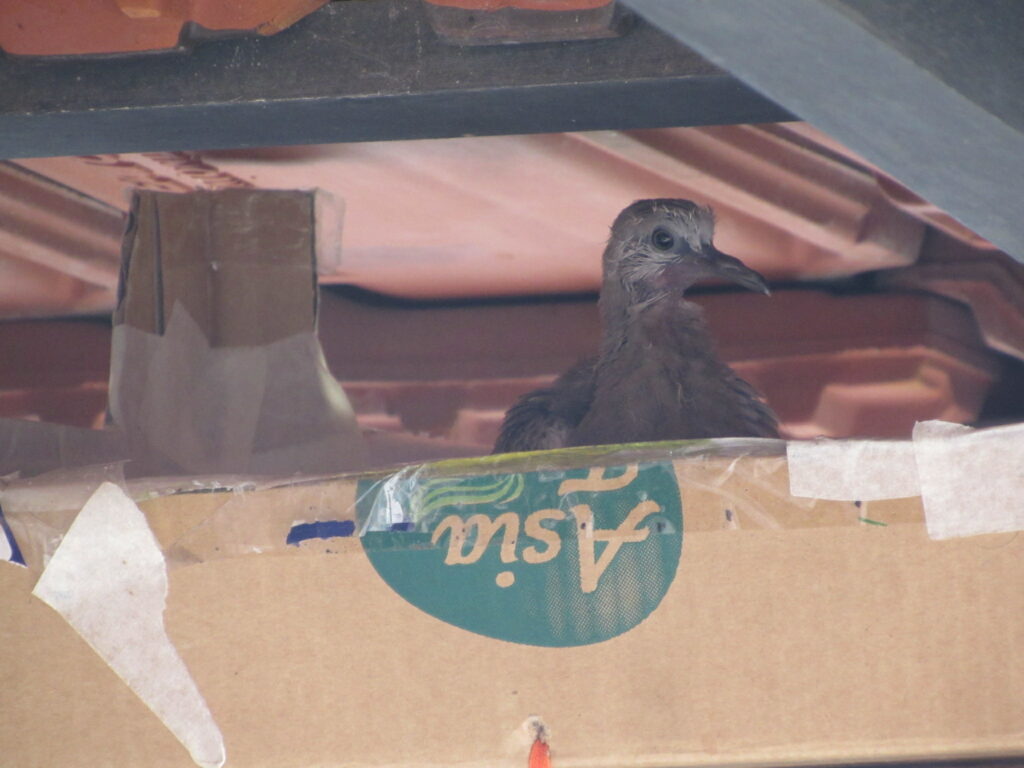I published the following post https://besgroup.org/2023/11/24/spotted-neck-dove-reproductive-history/ on 24 November 2023, summarising the critical stages of nesting and fledging of the young. I reproduce below the table summarising the events during 6 reproductive cycles of the Spotted neck dove, Spilopelia chinensis.
I continued studying this hardworking and cooperative pair, christened Andy and Betty. The second table summarises cycles 7 and 8. Both resulted in nesting disaster.

| Cycle no. | Incubation | Nestling | Hiatus (No. of days) | Special remarks |
| 7 | 11/11/2023-24/11/2023 | 25/11/1023 – 8/11/2023 | 8 | Full grown juvenile disappeared on day it was expected to fledge |
| 8 | 16/12/2023 – 22/12/23 | – | ? | Noted 1 egg on 16/12/2023, 2 eggs on 20/12/2023. Eggs disappeared on 22/12/2023. CCTV captured image of civet cat visiting nest. |
Cycle 7
I observed 1 egg in the nest on 11/11/2023 and then 1 chick in the nest on 24/11/2023. The chick developed normally and reached all its mile stones as in previous cycles. The chick was expected to fledge on 8/12/2023.

However, the nest was empty on 8 November 2023 morning and Betty was no where near the nest. From my observations so far the chicks fledge in the afternoons. I climbed up to examine the nest and found it empty. On closer examination of the floor below the nest I noticed small flight feathers torn off their shafts and strewn around. I also noticed clumps of strange turds(?) on the porch roof. My CCTV camera did not capture any encroachment of the nest.





Cycle 8
Betty returned to the nest and on 16/12/2023, just 8 days after the chick in cycle 7 disappeared. I found 1 egg in the nest. 2 eggs were observed on 20/12/2023. I sensed something was amiss on 23/12/2023 as neither Andy nor Betty were in the nest the whole morning. Around noon, Andy searched every nook and corner of the nest, calling extraordinarily loud. Every now and then, I heard Betty answering from a far distance. I climbed up to the nest and realised the eggs had disappeared. Betty never returned to the nest again until 8/1/2024.
The CCTV footage showed that Betty had been incubating at 10.39 pm the night before. The CCTV camera captured a large mammal retracting from the nest and slinking away on the roof rafter at 10.44 pm. It was a Palm Civet Cat, Paradoxurus hermaphroditus, also known as musang locally. Betty was not seen in the nest again. I conclude that Betty had been spooked by the Palm Civet Cat and that the eggs had been taken in the night.
Conclusion
During cycle 3, the eggs disappeared after 3 days’ incubation. I had not installed the CCTV camera yet. Could it have been the civet cat’s doing?
During cycle 7, the chick could have been taken from the nest in the night. The chick spends the last few nights alone in the nest before its first flight. Both Andy and Betty did not know that the chick had been predated on during the night and Andy kept calling for the chick to fly.
During cycle 8, Betty managed to escape the grips of the musang and refused to go anywhere near the nest again. At time of publishing (32 days lapse), Betty has not laid for the next cycle as I hear the pair exploring all the known nesting sites – my neighbour’s window sills, the trumpet flower (Solandra longiflora) vine and my roof space. They still feed in my garden.







